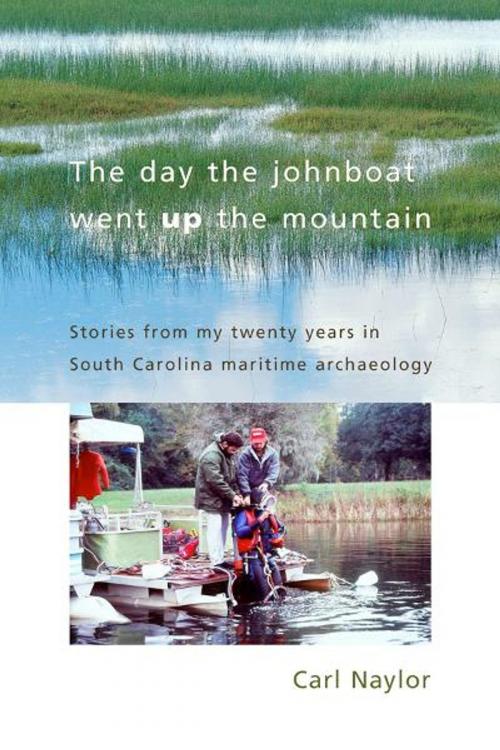The Day the Johnboat Went up the Mountain
Stories from My Twenty Years in South Carolina Maritime Archaeology
Nonfiction, History, Americas, United States| Author: | John Naylor | ISBN: | 9781611171341 |
| Publisher: | University of South Carolina Press | Publication: | June 5, 2012 |
| Imprint: | University of South Carolina Press | Language: | English |
| Author: | John Naylor |
| ISBN: | 9781611171341 |
| Publisher: | University of South Carolina Press |
| Publication: | June 5, 2012 |
| Imprint: | University of South Carolina Press |
| Language: | English |
Combining his skills as a veteran journalist and well-practiced storyteller with his two decades of underwater adventures in maritime archaeology, Carl Naylor offers a colorfully candid account of remarkable discoveries in the Palmetto State's history and prehistory. Through a mix of personal anecdotes and archaeological data, Naylor's memoir, The Day the Johnboat Went up the Mountain, documents his experiences in the service of the Maritime Research Division of the South Carolina Institute of Archaeology and Anthropology, a research arm of the University of South Carolina. Shared in a companionable tone, this insightful survey of Naylor's distinguished career is highlighted by his firsthand account of serving as diving officer for the excavation of the Confederate submarine H. L. Hunley in 1996 and the subsequent excavation of its victim, the USS Housatonic. He also recounts tales of dredging the bottom of an Allendale County creek for evidence of the earliest Paleoindians, exploring the waters off Winyah Bay for a Spanish ship lost in 1526 and the waters of Port Royal Sound for a French corsair wrecked in 1577, studying the remains of the historic Santee Canal near Moncks Corner, and searching for evidence of Hernando de Soto's travels through South Carolina in 1540. Naylor describes as well his investigations of suspected Revolutionary War gunboats in the Cooper River, a colonial and Revolutionary War shipyard on Hobcaw Creek, the famous Brown's Ferry cargo vessel found in the Black River, a steamship sunk in a storm off Hilton Head Island in 1899, and a mysterious cargo site in the Cooper River. Throughout these episodes, Naylor gives an insider's view of the methods of underwater archaeology in stories that focus on the events, personalities, and contexts of historic finds and on the impact of these discoveries on our knowledge of the Palmetto State's past. His narrative serves as an authoritative personal account of South Carolina's ongoing efforts to discover and preserve evidence of its own remarkable maritime history.
Combining his skills as a veteran journalist and well-practiced storyteller with his two decades of underwater adventures in maritime archaeology, Carl Naylor offers a colorfully candid account of remarkable discoveries in the Palmetto State's history and prehistory. Through a mix of personal anecdotes and archaeological data, Naylor's memoir, The Day the Johnboat Went up the Mountain, documents his experiences in the service of the Maritime Research Division of the South Carolina Institute of Archaeology and Anthropology, a research arm of the University of South Carolina. Shared in a companionable tone, this insightful survey of Naylor's distinguished career is highlighted by his firsthand account of serving as diving officer for the excavation of the Confederate submarine H. L. Hunley in 1996 and the subsequent excavation of its victim, the USS Housatonic. He also recounts tales of dredging the bottom of an Allendale County creek for evidence of the earliest Paleoindians, exploring the waters off Winyah Bay for a Spanish ship lost in 1526 and the waters of Port Royal Sound for a French corsair wrecked in 1577, studying the remains of the historic Santee Canal near Moncks Corner, and searching for evidence of Hernando de Soto's travels through South Carolina in 1540. Naylor describes as well his investigations of suspected Revolutionary War gunboats in the Cooper River, a colonial and Revolutionary War shipyard on Hobcaw Creek, the famous Brown's Ferry cargo vessel found in the Black River, a steamship sunk in a storm off Hilton Head Island in 1899, and a mysterious cargo site in the Cooper River. Throughout these episodes, Naylor gives an insider's view of the methods of underwater archaeology in stories that focus on the events, personalities, and contexts of historic finds and on the impact of these discoveries on our knowledge of the Palmetto State's past. His narrative serves as an authoritative personal account of South Carolina's ongoing efforts to discover and preserve evidence of its own remarkable maritime history.















